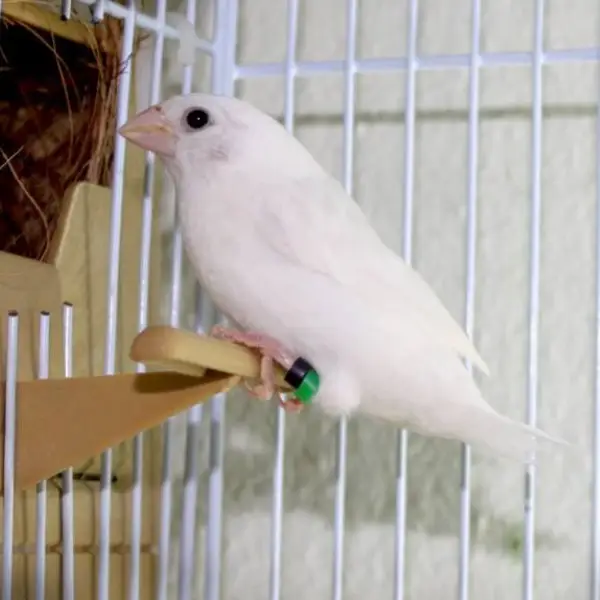Free shipping order over 20,000
Albino Black-Eye
₨ 5,000 Original price was: ₨ 5,000.₨ 4,000Current price is: ₨ 4,000.
-
-
-
-
- Scientific Name: Agapornis spp. (lovebirds; the exact species can vary depending on the specific type of lovebird)
- Size: Typically around 13-17 cm (5-7 inches) in length, depending on the species.
- Color: The Albino Black-Eyed Lovebird is characterized by its entirely white plumage, which is a result of a genetic mutation. Despite the overall white coloration, the most notable feature is the black eyes, which are unusual for albino birds (albinos generally have red or pink eyes). This distinctive combination of all-white feathers and dark eyes creates a striking contrast.
- Beak: The beak is generally a light color, often orange or pinkish, depending on the species.
- Eyes: Black and prominent, providing a dramatic contrast against the white feathers.
- Legs and Feet: Legs and feet are usually pale or flesh-colored.
-
-
-
SKU: REF. LA-5766-9-1-1-1-1-1-1-1-1-1-1-1-1-1-1-1-1-1-1-1-1-1-1-1-1
Categories: LOVE BIRDS, Uncategorized
Tag: love birds
Share
Share on facebook
Share on email
Important Keys:
Habitat
- Distribution: Lovebirds are native to Africa, with various species found in different regions. However, the Albino Black-Eyed Lovebird is typically bred in captivity and does not have a natural wild habitat.
- Environment: In captivity, they thrive in aviaries or large cages with plenty of space to fly, perch, and interact with other birds.
Diet
- Primary Food: Their diet mainly consists of seeds, including millet, canary seed, and other small seeds. They should also have a balanced mix of pellets.
- Supplementary Food: Fresh fruits, vegetables, and occasional protein sources like egg food or mealworms are important for a balanced diet.
- Feeding Behavior: They are ground feeders and may also forage for food in their environment. In captivity, they are usually provided with a mix of seeds and other food items in feeding dishes.
Breeding
- Breeding Season: In captivity, lovebirds can breed year-round if conditions are favorable.
- Nest Location: They prefer to build nests in enclosed spaces, such as nest boxes or dense foliage. In captivity, they use wooden or artificial nest boxes.
- Egg Quantity: Clutches generally consist of 4-6 eggs.
- Incubation Period: The eggs are incubated for about 21-23 days, with both parents sharing the responsibility.
- Fledging: Chicks typically fledge around 6-8 weeks after hatching.
Lifespan
- In the Wild: Lovebirds typically live around 10-15 years in the wild.
- In Captivity: With proper care, they can live up to 15-20 years or more.
Behavior
- Social Structure: Lovebirds are highly social and thrive in pairs or small groups. They are known for their affectionate and playful nature.
- Vocalization: They produce a variety of sounds, including chirps, whistles, and soft calls, which are used for communication and during social interactions.
![]()
Be the first to review “Albino Black-Eye” Cancel reply
Related Products
-
-30%
Gray Shaft Tail
₨ 20,000Original price was: ₨ 20,000.₨ 14,000Current price is: ₨ 14,000. -
-25%
Silver Gouldian Finch
₨ 24,000Original price was: ₨ 24,000.₨ 18,000Current price is: ₨ 18,000. -
-20%
Lotino Gouldian Finch
₨ 15,000Original price was: ₨ 15,000.₨ 12,000Current price is: ₨ 12,000. -
-20%
Common Gouldian Finch
₨ 12,500Original price was: ₨ 12,500.₨ 10,000Current price is: ₨ 10,000. -
-8%
Albino Cut-throat Finch
₨ 65,000Original price was: ₨ 65,000.₨ 60,000Current price is: ₨ 60,000. -
-19%
White Bengalese
₨ 1,850Original price was: ₨ 1,850.₨ 1,500Current price is: ₨ 1,500. -
-20%
Red Eyes Bengalese
₨ 3,750Original price was: ₨ 3,750.₨ 3,000Current price is: ₨ 3,000. -
-20%
White-tailed Dove
₨ 1,250Original price was: ₨ 1,250.₨ 1,000Current price is: ₨ 1,000.
Sign Up for Exclusive Birds Care Tips and Offers from Phool Panchi
Company links
Category
Contact
© 2024 Phool Panchi | Developed By v3Studio















Reviews
There are no reviews yet.